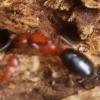For the past 5 months I've started a mini project on culturing the very common pantry pest, indian mealmoths. I think these are great feeders for people who don't want something high maintenance and or taking a while to reproduce. First of all you THESE ARE PESTS so be careful with harvesting or opening the container in general!! Also just to make sure no infestation occurs in your house after opening a culture, make sure to have any grain produce sealed TIGHTLY. I started this project because I had an infestation in my mealworm and superworm bins which lead to 100s of them crawling on my ceiling which absolutely sucked. This made me want to throw them in a container to see how many eggs they would end up laying, which by the way was a lot!
Steps for starting a culture:
1. You need a large cylindrical container - I used a giant cheese puff container after washing it out with soapy water.
2. The grain bedding - I use a mix of blended whole almonds, blended cat food, and wheat bran. You may also use just about anything grain based such as oats, cereal, maybe even some flowers, etc. Keep in mind what you feed them so that they are nutritious.
3. Some sort of surface area for harvesting and for moths to congregate - I use folder or wadded up paper towel.
4. The moths and or larva of course - it is quite likely that may already have them in your house, to "bait" them just set out a bowl of grain and the moths will lay their eggs on it. Once you notice webbing in the grain then you can put it into your container.
The life cycle of these buggers can range anywhere from months to a couple weeks depending on temperature. They are very low maintenance and easy to contain. The only thing you have to do is cycle cultures every now and then.
Harvesting them can be easy depending on the size of your container (which should be large). I just take out the surface area and shake the moths off and I'm left with the larger larva trying to pupate in it. The larva can get quite fat and have different colors depending on age. The smaller larva are reddish, the larger ones are white, and the biggest ones trying to pupate are green (black ones are dead). I'm unsure how the color relates to anything other than age however.
My success with these in the past 5 months has been surprising. So far I have literally thousands of various size larva in my bedding of one culture. Hopefully I got anyone else to try this out, as I think it is quite effective.
Picture of various size larva:

Picture of setups: Left one has oats and right has the almonds/cat food/wheat bran mix




















